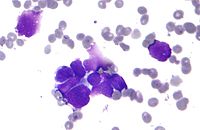
Photo from wikipedia
Purpose: This study aimed to establish a new nomogram that predicts recurrence-free survival (RFS) after a complete surgical resection of primary localized gastrointestinal stromal tumors (GISTs); it also aimed to… Click to show full abstract
Purpose: This study aimed to establish a new nomogram that predicts recurrence-free survival (RFS) after a complete surgical resection of primary localized gastrointestinal stromal tumors (GISTs); it also aimed to evaluate the discrimination, calibration, and clinical utility of the decision-making nomogram. Methods: The clinicopathological data of patients with primary localized GISTs at the First Affiliated Hospital of Chongqing Medical University from January 2000 to June 2022 were retrospectively analyzed. The clinicopathological data were randomly split into two sets (7:3 ratio) for training and validation. Suitable variables for the construction of a nomogram for the 1-, 3-, and 5-year RFS were selected using univariate and multivariate Cox regression analyses. Receiver operating characteristic (ROC) analysis and a concordance index (C-index) were used to quantify the discrimination of the nomogram and were compared with four commonly used prognostic scoring systems: Memorial Sloan Kettering Cancer Center prognostic nomogram, National Institutes of Health–Fletcher staging system, Chen’s prognostic nomogram, and Air Forces Institute of Pathology risk criteria–Miettinen staging system. The calibration and clinical utility for the decision-making nomogram were validated using calibration curves and decision curves, respectively. Results: In total, 641 patients were screened and analyzed in this retrospective, observational study. RFS was significantly related to tumor size, mitotic count, gender, DOG-1, and adjuvant therapy with imatinib according to the results of the multivariate and univariate Cox analyses. The nomogram was constructed using the above variables (all p < 0.05) for the 1-, 3-, and 5-year RFS. In the training set, the 1-, 3-, and 5-year ROC and C-index values of the nomogram were 0.868, 0.838, 0.816, and 0.830, respectively. For internal validation, we performed model fitting on the validation set, and the 1-, 3-, and 5-year ROC and C-indices were 0.977, 0.845, 0.869, and 0.849, respectively. Among the five GIST prognostic scoring systems, our nomogram had almost all the largest area under these decision curves and had a good calibration capability. Conclusions: The newly constructed nomogram based on tumor size, gender, mitotic count, DOG-1, and adjuvant treatment with imatinib exhibited an excellent performance and may serve as a prognostic scoring system to support therapeutic decision-making and individualized treatment for GISTs in China.
Journal Title: Journal of Personalized Medicine
Year Published: 2023
Link to full text (if available)
Share on Social Media: Sign Up to like & get
recommendations!